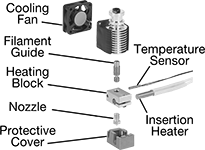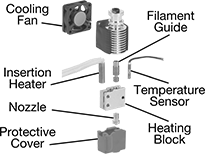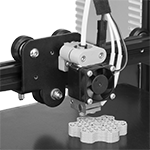3D Printer Extruder Heating Elements



Replace damaged heating elements in your 3D printer, or switch them out to print at a faster speed or higher temperature. Also known as hotends, these heating elements receive filament from an extruder, melt it, and then pass it through a nozzle onto the part being printed. They are compatible with most fused filament fabrication (FFF) 3D printers. Changes to the heating element or temperature cartridge will also require a software update, or your printer may overheat.

Select a heating element with a voltage and extrusion type that match your printer. In printers with a direct feed, the extruder is attached to the heating element, feeding filament directly into it. Tube feed extruders, also known as Bowden extruders, are mounted to the frame and pass filament through a tube to the heating element. Heating elements for tube feed printers come with tubing and a fitting that attaches to the extruder.
V6 heating elements are the industry standard. They heat up in minutes to melt most multipurpose and flexible filaments. All parts are precision-machined to print smoothly and prevent clogs. These heating elements are not designed for high-speed or high-temperature printing. They come fully assembled, which saves setup time and eliminates assembly mistakes.
| For Extrusion Type | For Filament Dia., mm | Nozzle Opening Dia., mm | Max. Temp. | Insertion Heater Wattage, W | Heating Block Material | Includes | Each | |
12V DC | ||||||||
|---|---|---|---|---|---|---|---|---|
V6 | ||||||||
| Direct Feed | 1.75 | 0.4 | 285° C 545° F | 30 | Aluminum | One 1-m Lg. Quick-Disconnect Cable for Temperature Sensor (Molex Female 2 Pin × Standard Male 2 Pin); Silicone Rubber Protective Cover | 0000000 | 000000 |
| Tube Feed | 1.75 | 0.4 | 285° C 545° F | 30 | Aluminum | One 1-m Lg. Quick-Disconnect Cable for Temperature Sensor (Molex Female 2 Pin × Standard Male 2 Pin); Silicone Rubber Protective Cover | 0000000 | 00000 |
24V DC | ||||||||
V6 | ||||||||
| Direct Feed | 1.75 | 0.4 | 285° C 545° F | 30 | Aluminum | One 1-m Lg. Quick-Disconnect Cable for Temperature Sensor (Molex Female 2 Pin × Standard Male 2 Pin); Silicone Rubber Protective Cover | 0000000 | 00000 |
| Tube Feed | 1.75 | 0.4 | 285° C 545° F | 30 | Aluminum | One 1-m Lg. Quick-Disconnect Cable for Temperature Sensor (Molex Female 2 Pin × Standard Male 2 Pin); Silicone Rubber Protective Cover | 0000000 | 00000 |

Shield your 3D printer's heating element, or hotend, from sticky filament buildup with these nonstick silicone covers. By repelling plastic and keeping the heating block clean, they increase the heating block's life and prevent stuck filament from dripping off and ruining prints.
Silicone is heat resistant, so these covers also insulate the heating block. An insulated heating block means more consistent extrusion temperatures and therefore better prints. The silicone also keeps heat away from the printed part to prevent it from warping.
Also known as socks, these covers are just as easy to put on and take off—slide on to install and peel off to remove.
Covers for heating block and nozzle protect the nozzle from PETG and other particularly sticky materials, which can gum up the nozzle. The material that surrounds the nozzle is very thin, though, so these covers wear out faster than covers that only protect the block.

Overall | ||||||||||||
|---|---|---|---|---|---|---|---|---|---|---|---|---|
| For 3D Printer Part Trade Name | Ht. | Wd. | Dp. | Airflow, cfm | Volume, dBA | Current, A | Frame Material | Blade Material | Mounting Fasteners Included | Mounting Hole Dia. | Each | |
12V DC—2-Pin Connector (Male Connection) | ||||||||||||
| V6, Volcano | 1.18" (30 mm) | 1.18" (30 mm) | (0.39") 10 mm | 4 | 35.6 | 0.15 | Plastic | Plastic | No | 0.12" (3 mm) | 00000000 | 000000 |
24V DC—2-Pin Connector (Male Connection) | ||||||||||||
| V6, Volcano | 1.18" (30 mm) | 1.18" (30 mm) | (0.39") 10 mm | 4 | 35.6 | 0.08 | Plastic | Plastic | No | 0.12" (3 mm) | 00000000 | 00000 |
V6 and Volcano
Heating Elements
Filament guides hold the filament as it melts in the heating block and moves toward the nozzle. Also known as heat breaks, they transition the filament from the cool area of the heat sink to the heating block.

Made of metal, heating blocks disperse heat from an insertion heater to evenly melt filament as it passes through. They also hold the temperature sensor and join the filament guide to the nozzle, making them an important connection point between parts of the heating element. Aluminum is the standard material for heating blocks, which works with V6 and Volcano heating elements.
For Nozzle Thread | For Insertion Heater | For Filament Guide Thread | ||||||||||||
|---|---|---|---|---|---|---|---|---|---|---|---|---|---|---|
| For Nozzle OD, mm | Lg., mm | Size | Pitch, mm | Max. Temp. | Cartridge Dia., mm | Orientation | For Temp. Sensor Cartridge Dia., mm | Lg., mm | Size | Pitch, mm | Material | Mounting Fasteners Included | Each | |
V6 | ||||||||||||||
| 0.15, 0.25, 0.3, 0.35, 0.4, 0.5, 0.6, 0.8 | 6 | M6 | 1 | 285° C 545° F | 6 | Perpendicular to Nozzle | 3 | 5 | M6 | 1 | Aluminum | Yes | 0000000 | 000000 |
Protective Covers for 3D Printer Extruder Heating Elements

Shield your 3D printer's heating element, or hotend, from sticky filament buildup with these nonstick silicone covers. By repelling plastic and keeping the heating block clean, they increase the heating block's life and prevent stuck filament from dripping off and ruining prints.
Silicone is heat resistant, so these covers also insulate the heating block. An insulated heating block means more consistent extrusion temperatures and therefore better prints. The silicone also keeps heat away from the printed part to prevent it from warping.
Also known as socks, these covers are just as easy to put on and take off—slide on to install and peel off to remove.
Covers for heating block and nozzle protect the nozzle from PETG and other particularly sticky materials, which can gum up the nozzle. The material that surrounds the nozzle is very thin, though, so these covers wear out faster than covers that only protect the block.

























